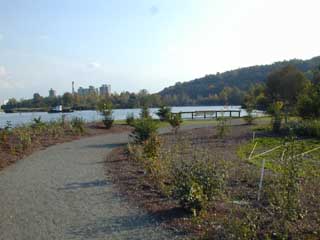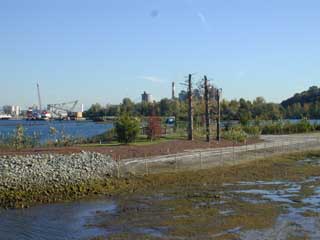
Surveys
DJC.COM
July 12, 2001
Environmental metamorphosis on the Duwamish
J.A. Brennan Associates

Herring’s House Park, the site of the old Seaboard Lumber mill, is now a place for passive recreation and home to intertidal wetlands. |
It is possible to undo the ravages of past industrial practices on the land. A look at the recently rehabilitated Seaboard Lumber aquatic site demonstrates that a collaborative approach can revert industrial wasteland to productive habitat. Environmental theory and practice coalesce to create an intertidal estuary that enhances the habitat of endangered chinook salmon and other wildlife.
In the industrial corridor of Seattle’s lower Duwamish River, J.A. Brennan Associates worked with a team of professionals to set habitat goals that could combat over 65 years of environmental damage. Obstacles included cleaning up contaminated soil and industrial debris, calming the harsh wave environment of a shipping channel, and satisfactorily meeting regulatory requirements.
Setting a goal
Seattle Department of Parks and Recreation and the Elliott Bay/Duwamish Restoration Program Panel (EBDRP) set a goal for restoring aquatic habitat to the Duwamish River system to protect and enhance critical fish and wildlife habitat. The Department of Parks was interested in providing limited passive recreation and public education opportunities.

Photos courtesy of J.A. Brennan Associates The inlet at Herring’s House Park at low tide. Juvenile salmon are already utilizing the created estuary as a resting and feeding area. |
The first step in the project was to determine project feasibility. Brennan Associates prepared a range of preliminary concepts to determine the feasibility and benefits of developing the site for aquatic habitat restoration. A number of options were presented to the Department of Parks and the EBDRP Panel.
A consideration in site selection was that the site was uniquely located adjacent to the last natural oxbow of the Duwamish estuary, and barring site restoration, future site uses would invariably remain industrial and the opportunity for building on the existing habitat would be forever lost. The project was determined to be feasible and the site of the former Seaboard Lumber mill was purchased by the city of Seattle in 1997.
Estuary restoration
Brennan Associates worked closely with a team of scientists — including an estuarine ecologist, wetlands ecologists and fisheries biologist, in addition to permit specialists and tribal and agency representatives — on the Elliott Bay Duwamish Restoration Program Panel to identify specific restoration goals for the project.
| TEAM: |
|
The design team determined that the best way to restore productive habitat for salmon was to focus on creating a self-sustaining intertidal estuary that would function naturally in harmony with the adjacent intertidal habitat. Design criteria for the intertidal estuary included minimizing the effects of sedimentation, tidal flows, boat wakes, wind action, floating debris and surrounding noise — while maximizing high marsh habitat and mudflats for juvenile salmon refuge and food production.
Implementation of the design included excavation of an intertidal basin, construction of shoreline projection, and introduction of aquatic and upland improvements.
Over 16,000 cubic yards of soil were removed, and new soil was brought in to cover over low-level petroleum-contaminated soil deemed safe to remain on site. Old creosote pilings, broken rock, asphalt, brick, concrete and metal debris were removed from the shoreline and property.
Undulating berms were constructed, along with two spits to protect the new estuary. The design created 900 linear feet of new shoreline and 1.8 acres of intertidal estuary.
Native plant species create a diverse habitat at the new estuary. Habitat types include forest, meadow and dune. Snags and woody debris were incorporated into the design to provide upland site enhancements for birds and other wildlife.
The brackish marsh provides juvenile salmon with a feeding and resting area critical in their adjustment period between the upstream fresh water environment and the salt water of Puget Sound.
To minimize the impact of a large population of geese, temporary cages and a twine grid have been used to protect the intertidal salt marsh plants from predation. After a period of settling, additional plantings may be made dependent upon the results of the adaptive management plan.
The adaptive management plan
Another important and unique element of the project is the Department of Parks’ acknowledgement of the importance of post construction monitoring of the site.
J.A. Brennan Associates has put together an adaptive management plan for the project. The site is visited monthly to document changes, complete a photographic survey and to address maintenance issues. The information gained allows us to judge the project’s success and make any adjustments that may make the habitat more attractive to wildlife.
We are able to monitor the effects of geese and wind, plant health and maintenance measures to gain an understanding of how future management actions can lead to long-term project success.
Specifically, observation will play a large role in determining whether the initial planting of brackish marsh plants will stimulate volunteer colonization over the entire salt marsh area. Observation will also show whether invasives are colonizing the site and how the hydrodynamics of tidal flushing is affecting the basin sediments.
Why landscape architects?
Landscape architecture encompasses a wide range of design issues. It not only integrates people and the landscape, but its theories can be instrumental in repairing the damage of past industrial practices. Landscape architects have the practical experience and knowledge to take science, interpret it, and implement it, thereby creating a living and sustainable environment. Elements integral to the success of projects such as this one include:
1. Guiding stewardship: The role of scientists is to set project goals and to create guidelines for design elements. Landscape architects can take these ideas and incorporate them into a design that works for the site, for enhancement of species diversity, and for permitting agencies.
2. Creating a vision: Through design collaboration with agencies, the public and owners, Landscape architects are able to take guidelines and incorporate them into a design that works on an aesthetic level.
3. Coordinating the process: Landscape architects understand how projects get constructed. We are familiar with the reality of what can be created with limited amounts of space, time and money. We understand the public process and are able to coordinate with agencies and the public to get projects through permitting. We know how to create construction documents.
4. Following-up: Landscape architects are committed to creating sustainable environments. A perfect example of this is utilizing adaptive management plans: learning what works and what could be improved upon. A living and sustainable project requires on-going management.
Oasis
This project is not the only oasis in Seattle’s industrial heartland. Herring’s House Park is one pearl on the necklace of green and rehabilitation in the Duwamish Corridor. J.A. Brennan Associates is also working with the Port of Seattle to develop the adjacent 10-acre Duwamish River Park that will feature enhanced shoreline habitat, passive recreation and education elements.
The adjacent Kellogg Island also provides marsh and mudflats for fish habitat. Many environmental projects supporting the goal of fish and wildlife habitat work together to recreate what we have lost over the last 100 years. The Duwamish River is dotted with these projects and more are ahead.
On the day of the park’s ribbon cutting ceremony — June 4, 2001 — an osprey and a bald eagle flew overhead and schools of juvenile salmon swam in the salt marsh near the shore.
Christine Nack is the marketing coordinator and Tanja Wilcox is a senior associate landscape architect at J.A. Brennan Associates in Seattle.
Other Stories:
- Pesticide-free parks teach new lessons
- Construction faces new foe: toxic mold
- Water metering: the debate trickles on
- Studies sniff out Tacoma smelter plume
- Tree investment brings cities many happy returns
- From wood preservation to site remediation — the Cascade Pole cleanup
- New rules for birds, bogs and bulldozers
- Isolated wetlands ruling creates confusion
- Mitigation banks balance habitat, development
- New Pin Foundation minimizes site impacts
- Bringing a city stream back to life
- Knitting a trail of green
- Stormwater problems? Put a LID on it
- More brownfield incentives in the pipeline
- SEPA document trends since GMA and regulatory reform
- Helping environmental groups to get wired
- Shedding light into the permit ‘black hole’
- Frequently asked ESA questions
- Muddy waters: The new 4(d) salmon rule
- Global climate change starts at home
- At EPA, next 4 years won’t be boring
- Dams vs. fish? Mediate it!
- 'House calls' help firms to conserve
- Building a greener future on Bainbridge
- Power users, producers turn toward the sun
- Seattle goes climate neutral
- Bamboo’s popularity shoots up
- Tiny town recycles Goliath proportions
- MTCA revisions take effect Aug. 15
- Environmental education: Knowing what’s in your backyard
- Bear Creek roars again
- UW Bothell — a wetland lesson in the making
Copyright ©2009 Seattle Daily Journal and DJC.COM.
Comments? Questions? Contact us.